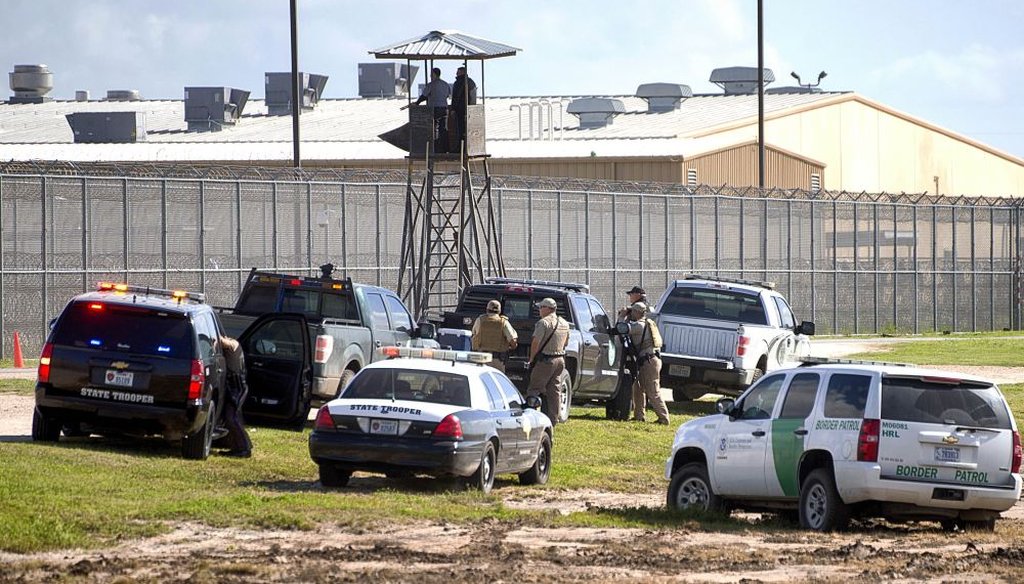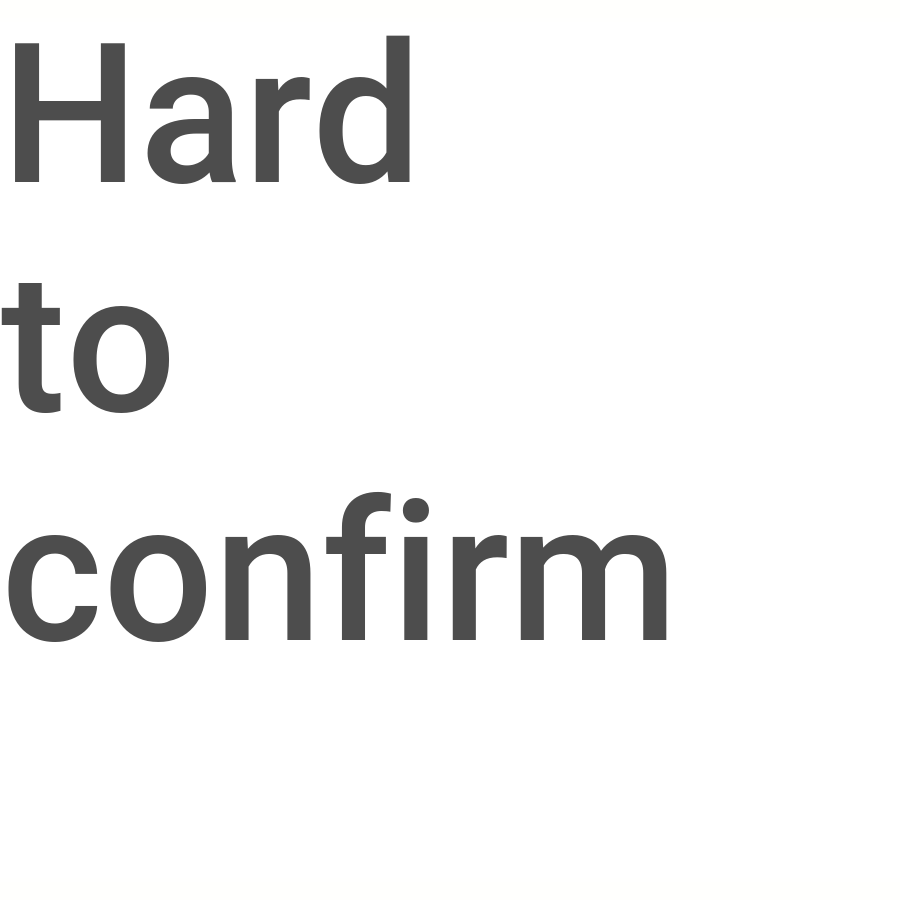Stand up for the facts!
Our only agenda is to publish the truth so you can be an informed participant in democracy.
We need your help.
I would like to contribute

In 2015, law enforcement officials converged on the Willacy County Correctional Center in Raymondville, Texas in response to an uprising at the private immigration detention center. The facility is now closed. (2015 AP file photo)
The cornerstone of President Donald Trump’s 10-point immigration plan — "build the wall" — has earned most of the headlines. But the Trump administration is plunging forward with several other plans that are lesser known, including an expansion of detention centers for immigrants in the country illegally.
Trump seeks to eliminate so-called "catch-and-release" — the practice of releasing immigrants apprehended at or near the border, expecting them to appear at a later date before a U.S. immigration judge. His plan is to detain all immigrants waiting for deportation or a resolution of their case.
That move concerns immigrant advocates, who have warned about poor standards and the mistreatment of detainees at detention facilities.
John Kelly, who was Homeland Security secretary before he became White House chief of staff, told members of a House committee in May that standards may have to be lowered so the government can sign more contracts with local jails to hold immigrants in transition.
Standards would not be lowered to the point of violating human rights, Kelly assured lawmakers.
"ICE detention standards are well beyond the standards that even the Federal Bureau of Prisons has in terms of prisoner or detainee, in this case, housing and care," Kelly said. "As we seek to enter into, if you will, rental agreements with local law enforcement or counties to have access to their beds for generally short periods of time, in order to do that we're looking at lowering our standards so that we can enter into agreements."
Information about detention facilities is difficult to obtain, inconsistent and outdated, and overall lacking in transparency. Due to the complexity of on-the-ground conditions, Kelly’s comparison is difficult to verify, so we won’t be issuing a Truth-O-Meter rating.
The bottom line: Unlike the prisons system, regulations on individual immigrant detention centers can be avoided through loopholes and requests for exceptions, experts said.
"Because there are a wide range of facilities, and a wide range of contracts with public and private entities, the whole system is wildly unequal," said David Hernández, a professor at Mount Holyoke College who specializes in detention and deportation policy.
PolitiFact delved into the details of the president’s proposal, reviewing standards at facilities and allegations of mistreatment at private and government-operated facilities.
The 'Trump Era': More immigrants in detention centers
Immigration detention centers do not hold people who have been found guilty of a crime or even people accused of crimes. Instead, they hold people who await civil procedures concerning their immigration status. The average daily population of immigrants in detention varies, but as of July 1, it was around 38,600, according to ICE.
Immigrants are housed at 201 authorized adult detention facilities and 213 other facilities such as family centers, Bureau of Prisons facilities, and hospitals, said ICE spokeswoman Danielle Bennett.
Previous administrations did not hold all immigrants in detention, often citing a lack of space. Trump is reversing that.
In a Jan. 25 executive order, Trump called for the allocation of "all legally available resources" for the immediate construction, operation and control of detention facilities near the border with Mexico, or for the establishment of contracts for such facilities.
"Pursuant to the president's executive order, we will now be detaining all adults who are apprehended at the border. They will not be released," Attorney General Jeff Sessions said April 11 in the border city of Nogales, Ariz.
It’s all part of a new Trump era, Sessions said.
"For those that continue to seek improper and illegal entry into this country, be forewarned, this is a new era. This is the Trump era. The lawlessness, the abdication of duty to enforce our laws and the catch-and-release policies of the past are over," Sessions said.
To expedite the court process and reduce backlogs, Sessions plans to hire more immigration judges (50 this year and 75 more in 2018) and has "streamlined" the process to reduce the time it takes to hire judges. He wants to end waits of up to two years to get new judges on the bench.
In a February memo, Kelly left room for discretionary parole on a case-by-case basis "and only for urgent humanitarian reasons or significant public benefit."
The Trump administration expects its new policies will help curb illegal immigration, yet experts say immigrants are already aware that if they are caught, there will be consequences.
"The noncitizens I meet fully believe they will be arrested, detained, and deported if they violate the immigration laws and are caught, so the deterrent effect is already there," said Cindy Buys, an immigration law professor at Southern Illinois University.
The Trump administration plans to populate detention centers not just with new immigrants who arrive illegally, but also with people who have long been breaking the nation’s immigration laws.
Trump has emphasized that immigrants who are criminals and who threaten public safety will be a top priority for deportation. But his expanded list of individuals prioritized for removal include: people who have been charged with a criminal offense, even if not yet convicted; who have committed an act that may be a chargeable criminal offense, or have abused programs issuing public benefits. Anyone in the country illegally is subject to deportation.
Reuters reported on June 6 that new guidance for ending "catch-and-release" under Trump had yet to be issued, and that immigrants "deemed to be low security risks" were still being released. We did not get a response from DHS to repeated questions on whether new, specific directives had been passed down to on-the-ground immigration officials.
Small fraction of detention centers subject to latest standards
Throughout the years, watchdog groups and advocates have reported neglect and inadequate conditions at several immigration detention facilities operated by U.S. Customs and Immigration Enforcement and contracted facilities.
Not all detention centers adhere to the same standards. There are different sets of standards from 2000, 2008 and 2011. Standards are not legally binding, and the set a facility is expected to follow depends on when it signed its government contract.
The 2011 standards were crafted to reinforce protections against sexual abuse and assault, increase recreation and access for visitation, legal services and religious opportunities, according to ICE. They were also revised to improve medical and mental health services, communication with detainees with limited English proficiency, and the process for reporting and responding to complaints.
Only 31 of all ICE and contracted facilities follow the 2011 standards.
Documents outlining the most recent standards point out the flexibility for their compliance, saying they were "drafted to include a range of compliance, from minimal to optimal" and that they "can be implemented widely."
At first, federal officials largely modeled immigration standards after prison standards, with some leniencies carved out because of unique issues pertaining to the immigrant population, said Holly Cooper, co-director of the Immigration Law Clinic at the University of California-Davis, School of Law.
Reports say problems abound, government slow to respond
In November 2016, as Trump celebrated his Election Day win, DHS inspectors paid a visit to the Theo Lacy Facility operated by the Orange County Sheriff’s Department in California.
The investigators were not pleased with what they saw.
According to the March 2017 final report of the DHS Office of Inspector General, the inspectors found food that appeared to be spoiled. They found that the male-only facility allowed high-risk and low-risk detainees to mix in some areas. They reported that the facility had "more restrictive" disciplinary segregation that violated ICE’s detention standards.
Inspectors also found that ICE did not track written grievances from detainees, and that the agency did not have access to reported grievances because they are kept in a database by a private contractor.
Persistent issues also exist at facilities for convicted criminals. But at immigration facilities, "you can’t just ask people how’s your treatment," said Cooper, co-director of the immigration law clinic at the University of California-Davis, School of Law.
That’s because immigrants who were subject to abuse back in their own countries don’t realize they can speak up against bad conditions within U.S. detention facilities, Cooper said.
"They don’t want to be seen as complaining. Some of them grew up on the streets," Cooper said. "You see more hesitation from immigrants to fight for better care. They are more afraid of retaliation."
Immigrant advocates are especially concerned about a lack of information on practices at private facilities. Much of the information that’s available to advocates has been obtained through Freedom of Information Act requests and lawsuits against the government.
"It is difficult to determine exactly which administrative standards apply to different facilities, because ICE and its contractors have resisted attempts to make detention facility contracts and inspection reports publicly available, despite the fact that these lucrative contracts are funded by taxpayers," said a November 2016 report from the Southern Poverty Law Center.
The Southern Poverty Law Center conducted a seven-month investigation of six immigrant detention facilities in the South, where immigrants are detained for months and sometimes years as they wait for their case to go through the court system. The group analyzed three private facilities and three run by county sheriffs.
"From facility to facility, their stories are remarkably similar accounts of abuse, neglect and rights denied — symptoms of an immigrant detention system where the failures of the nation’s immigration system intersect with the failures of its prison system," the report said.
Findings by the Southern Poverty Law Center include deaths of detainees while in custody, inadequate medical care, assaults by guards and servings of spoiled food.
Detention Watch Network, a national coalition of organizations and individuals advocating for changes in immigration detention and for immigrant rights, reported that since 2003, 155 people have died in immigration custody.
Detention Watch Network, the American Civil Liberties Union and National Immigrant Justice Center reviewed eight in-custody deaths from 2010 to 2012 in which "egregious violations" of ICE’s medical care standards "played a significant role," according to their February 2016 report.
Advocacy group Community Initiatives for Visiting Immigrants in Confinement in April filed a federal complaint with DHS’ Office for Civil Rights and Civil Liberties regarding the "prevalence of reports of sexual abuse, assault, and harassment in U.S. immigration detention facilities and the lack of adequate government investigation into these reports."
Human Rights Watch in May published a report that found "serious lapses in health care" that led to "severe suffering and at times the preventable or premature death of individuals" in immigration detention facilities.
While ICE has been notified about allegations of abusive conditions in facilities, it "often does not respond for years or responds in ways that are deemed completely inadequate," the report said.
Less oversight exists over immigration detention than criminal incarceration in part because a very high percentage of centers are run by private, for-profit corporations, said Denise Gilman, director of the Immigration Clinic at the University of Texas School of Law. Private facilities are able to avoid liability more easily and can even sometimes avoid scrutiny of contractual arrangements, she said.
"Audits are often conducted of these private immigration prisons by other private companies in the same correctional industry, so that they are not objective and robust," Gilman said.
The government prefers an audit system as a method of maintaining standards instead of building higher standards into the contracts, according to Hernández, the Mount Holyoke College professor. To re-contract entities with new, higher standards will give the jailer the ability to extract higher fees from the government, he said.
But lower standards at contracted facilities may lead to more violations, said Gilman, who believes detention standards "should be significantly higher in the immigration context."
"Most individuals in immigration detention have never been accused, much less convicted, of a crime," Gilman said. "Even those who have committed a crime have already fulfilled that criminal sentence and are now held only on an administrative immigration matter."
PolitiFact would like to speak with people with direct experience of being housed in immigration centers. Please contact us at [email protected].
Our Sources
PolitiFact, PolitiFact Sheet: Donald Trump’s immigration plan, Nov. 9, 2016
Archive.org, Homeland Security Secretary Testifies on FY 2018 Budget CSPAN, May 27, 2017
Email interview, David Hernández, a professor at Mount Holyoke College, June 7, 2017
White House, Executive Order: Border Security and Immigration Enforcement Improvements, Jan. 25, 2017
Justice Department, Attorney General Jeff Sessions Delivers Remarks Announcing the Department of Justice’s Renewed Commitment to Criminal Immigration Enforcement, April 11, 2017
Department of Homeland Security, Memo: Implementing the President's Border Security and
Immigration Enforcement Improvements Policies, Feb. 20, 2017
Email interview, Cindy Buys, an immigration law professor at Southern Illinois University, July 7, 2017
PolitiFact, Trump moves on promises on immigration, deportations in first month, Feb. 24, 2017
Reuters, Despite Trump vow to end catch and release, he is still freeing thousands of migrants, June 6, 2017
U.S. Customs and Immigration Enforcement, ICE Detention Standards, Feb. 24, 2012
Department of Homeland Security, Performance-Based National Detention Standards 2011, Revised December 2016
Phone interview, Holly Cooper, co-director of the Immigration Law Clinic at the University of California-Davis, School of Law, June 7, 2017
Email interview, Denise Gilman, director of the Immigration Clinic at the University of Texas School of Law, June 7, 2017
Email exchange, ICE spokeswoman Danielle Bennett, May 30-July 27, 2017
Office of Inspector General, Department of Homeland Security, Management Alert on Issues Requiring Immediate Action at the Theo Lacy Facility in Orange, California, March 6, 2017
Southern Poverty Law Center, Shadow Prison Immigrant Detention In The South, Nov. 21, 2016
Detention Watch Network, Immigration Detention 101
ImmigrantJustice.org, Fatal Neglect, How ICE Ignores Deaths in Detention, February 2016
Community Initiatives for Visiting Immigrants in Confinement, Sexual Assault in Immigration Detention, April 11, 2017
Human Rights Watch, Systemic Indifference Dangerous & Substandard Medical Care in US Immigration Detention, May 8, 2017


 PolitiFact Rating:
PolitiFact Rating: 







































